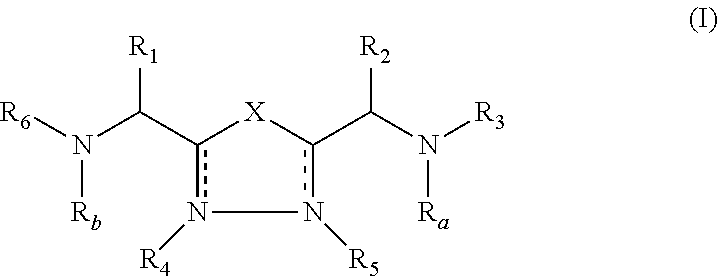1,3,4-oxadiazole and thiadiazole compounds as immunomodulators
a technology of oxadiazole and thiadiazole, which is applied in the field of 1, 3, 4oxadiazole and thiadiazole compounds and their derivatives, can solve the problems of immune tolerance breakdown and pathogenic autoimmunity, and achieve the effect of suppressing and/or inhibiting the programmed cell death 1 (pd-1) signaling pathway
- Summary
- Abstract
- Description
- Claims
- Application Information
AI Technical Summary
Benefits of technology
Problems solved by technology
Method used
Image
Examples
example 1
Synthesis of Compound 1
Step 1a
[0340]
[0341]Potassium carbonate (1.8 g, 13.0 mmol) and methyl iodide (0.65 mL, 10.4 mmol) were added to a solution of compound 1a (3.0 g, 8.7 mmol) in DMF (25 mL) and stirred at room temperature for 2 h. The completeness of the reaction was confirmed by TLC analysis. The reaction mixture was partitioned between water and ethyl acetate. The organic layer was washed with water, brine, dried over Na2SO4 and evaporated under reduced pressure to yield 3.0 g of compound 1b. LCMS: 361.1 (M+H)+.
Step 1b
[0342]
[0343]Hydrazine hydrate (3.3 mL, 8.3 mmol) was added to a solution of compound 1b (3.0 g, 8.3 mmol) in methanol (20 mL) and stirred at room temperature for 5 h. The completeness of the reaction was confirmed by TLC analysis. The volatiles were evaporated under reduced pressure and the residue obtained was partitioned between water and ethyl acetate. The organic layer was washed with water followed by brine solution. The separated organic layer was dried over...
example 2
Synthesis of Compound 32
Step 32a
[0357]
[0358]A solution of 4-nitro phenol (1.3 g, 9.99 mmol) and pyridine (0.8 mL, 9.99 mmol) in Et2O (20 mL) was added drop wise to a solution of SO2Cl2 (0.8 mL, 9.99 mmol) in Et2O (20 mL) at −78° C. under argon atmosphere. The reaction mixture was allowed to attain room temperature and stirred for 4 h. The completeness of the reaction was confirmed by TLC analysis. The reaction mixture was evaporated under reduced pressure to yield crude compound. The crude compound was purified by silica gel column chromatography (Eluent: 0-3% ethyl acetate in hexane) to yield 1.2 g of compound 32a. 1H NMR (400 MHz: CDCl3) 8.39-8.36 (tri 2H), 7.61-7.57 (m 2H).
Step 32b
[0359]
[0360]A solution of compound 32b (0.6 g, 2.59 mmol), molecular sieves (1.0 g), 4-nitrophenol (0.72 g, 5.18 mmol) and Et3N (1.1 mL, 7.77 mmol) in dry CH2Cl2 (25.0 mL), was added drop wise to a solution of compound 32a (1.2 g, 5.18 mmol) in dry CH2Cl2 (5.0 mL) at −78° C. under argon atmosphere. Reac...
example 3
Rescue of Mouse Splenocyte Proliferation in the Presence of Recombinant PD-L1
[0367]Recombinant mouse PD-L1 (rm-PDL-1, cat no: 1019-B7-100; R&D Systems) were used as the source of PD-L1.
Requirement:
[0368]Mouse splenocytes harvested from 6-8 weeks old C57 BL6 mice; RPMI 1640 (GIBCO, Cat #11875); DMEM with high glucose (GIBCO, Cat #D6429); Fetal Bovine Serum [Hyclone, Cat #SH30071.03]; Penicillin (10000 unit / mL)-Streptomycin(10,000 μg / mL) Liquid (GIBCO, Cat #15140-122); MEM Sodium Pyruvate solution 100 mM (100×), Liquid (GIBCO, Cat #11360); Nonessential amino acid (GIBCO, Cat #11140); L-Glutamine (GIBCO, Cat #25030); Anti-CD3 antibody (eBiosciences—16-0032); Anti-CD28 antibody (eBiosciences—16-0281); ACK lysis buffer (1 mL) (GIBCO, Cat #-A10492); Histopaque (density-1.083 gm / mL) (SIGMA 10831); Trypan blue solution (SIGMA-T8154); 2 mL Norm Ject Luer Lock syringe-(Sigma 2014-12); 40 μm nylon cell strainer (BD FALCON 35230); Hemacytometer (Bright line-SIGMA Z359629); FACS Buffer (PBS / 0.1%...
PUM
| Property | Measurement | Unit |
|---|---|---|
| Fraction | aaaaa | aaaaa |
| Fraction | aaaaa | aaaaa |
| Time | aaaaa | aaaaa |
Abstract
Description
Claims
Application Information
 Login to View More
Login to View More - R&D
- Intellectual Property
- Life Sciences
- Materials
- Tech Scout
- Unparalleled Data Quality
- Higher Quality Content
- 60% Fewer Hallucinations
Browse by: Latest US Patents, China's latest patents, Technical Efficacy Thesaurus, Application Domain, Technology Topic, Popular Technical Reports.
© 2025 PatSnap. All rights reserved.Legal|Privacy policy|Modern Slavery Act Transparency Statement|Sitemap|About US| Contact US: help@patsnap.com



